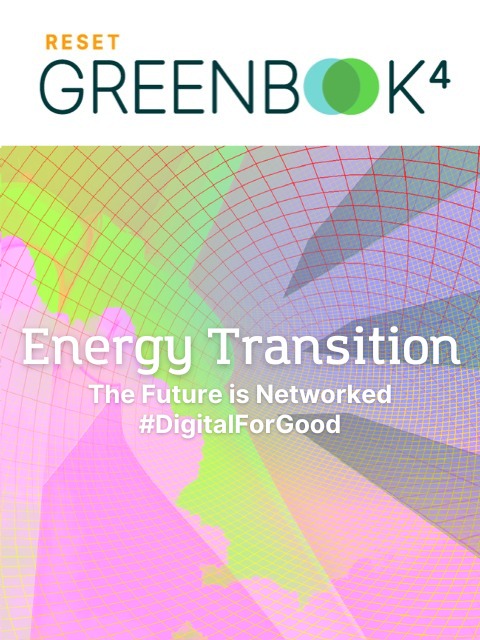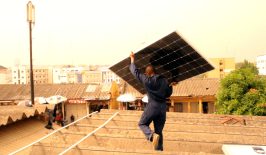Community energy supply and sharing concepts are beginning to show promise when it comes to decentralising energy sources. Having more actors in the market is key to moving forward the transition away from fossil fuels, and digitalisation plays an important role here. Nevertheless, digital technologies themselves are also energy-hungry. However, for smart meter rollouts, design could make an impact in keeping additional energy and resource consumption as low as possible.
Over a third of Germany’s total carbon emissions come from electricity generation and district heating in public power plants and from producing coal and mineral oil products. German and European climate goals can therefore only be achieved with a rapid energy transition towards 100 percent renewable energies.
Wind, solar, biomass, and hydro are already important energy sources; their contribution to electricity production rose from just 6.5 percent in 2000 to 41.1 percent in 2021 (Umweltbundesamt, 2022). But the expansion of renewable energy is difficult without increasing the decentralisation of energy sources and allowing more actors to participate in the market. In particular, concepts related to community energy supply and energy sharing show promise in this area. Related projects involve citizens developing wind or solar power plants in their neighbourhoods and then receiving the electricity produced at a reduced cost. In this way, the energy transition is not only left to the will of politicians and the energy industry, but private commitment and capital are integrated into the transformation process. The process could not only accelerate expansion but also increase acceptance for any changes; why should I take a (not in my backyard) approach when I can directly benefit financially from a wind turbine or a solar plant? (Salecki & Hirschl, 2021).
Simulations and modelling of shared energy supply models have shown that these approaches — also known as prosumer models — not only offer considerable economic advantages but also have great potential to advance the energy transition in the EU (Doračić et al., 2020). According to an analysis by the IÖW (Wiesenthal et al., 2022), energy sharing in Germany could contribute to the 42 percent (75 GW) increase in renewable capacities laid out in the German government’s 2030 expansion targets.
Digitalisation plays a key role in decentralising energy production and supply and making them more flexible. Above all, it serves as an enabler of a decentralised, renewable energy system by creating the necessary infrastructure (RESET Greenbook, 2022). New, intelligent measurement and communication technologies make it possible to record and evaluate information on electricity production, transport, storage, and consumption in real time and to control electricity flows on this basis. In addition, consumption can be made more flexible (Elberg et al., 2018), for example, by switching on the heat pump or refuelling an electric car exactly when wind or solar energy production is running at full speed. But all these applications are based on consumers being equipped with smart meters.
Smart meters in energy communities
Smart meters not only collect consumption data at regular intervals and pass this information on to consumers, but they can also transmit it automatically and manage access rights. By connecting energy suppliers, consumer devices and the electricity grid, they can form an important interface for controlling decentralised electricity generators such as photovoltaic or wind energy plants as well as for organising energy communities or joint self-consumption. In addition, smart meters can be used to introduce flexible electricity tariffs that take into account price fluctuations, grid loads, and electricity demand.

The 1.5 degree target is unattainable without a real transformation of our energy system. But how can it succeed? What are the energy sources of the future? What digital solutions are ready and where are innovations needed? And how can the transformation be driven forward?
The RESET Greenbook “Energy Transition – The Future is Networked” presents digital, innovative solutions and sheds light on the background.
In the Newtonprojekt passive house development in Berlin’s Adlershof district, a pioneering tenant electricity project has already been implemented. The project includes solar systems on the roofs of the houses and facades, a solar thermal system managing hot water supply, battery storage for electricity surpluses, and a fed-in connection to a district heating network if too much heat is produced. In addition, residents have access to 17 charging points for electric cars and e-bikes, which charge electric vehicles with locally generated electricity.
To ensure that electricity generation and use are ideally coordinated and to achieve the highest possible electricity self-sufficiency, the project’s green energy provider has installed a local electricity grid with smart meters and intelligent tariffs. With a two-tariff model, residents are motivated to use as much of the electricity generated on-site as possible. For the electricity from their own roof, they pay a reduced tenant electricity tariff. «By recording electricity generation and consumption with smart meters — for each generation and consumption point — the residents end up with an individual electricity price that is made up of the share of local electricity they use and the share of grid electricity. This means that the highest possible direct consumption is rewarded directly via the electricity price», explains Florian Henle, Managing Director of Polarstern (Polarstern s.a.).
Smart Grids? Lost in regulatory framework
In Germany, however, the essential prerequisites for smart, decentralised grids and the integration and flexibilising of all actors have not yet been created. The existing structures make it difficult to establish energy communities: The EU anchored energy sharing in the Renewable Energies Directive in 2019, but the regulatory framework is long overdue in Germany (BUND, 2021). Furthermore, we are only at the beginning of digitalisation at the level of households or consumption communities.
Even though the German Act on the Digitisation of the Energy Transition pursues the goal of creating a digital infrastructure for metering point operation in the electricity and gas sector, we are still a long way from achieving the goal. However, with the Act to Relaunch the Digitisation of the Energy Transition by the Federal Ministry for Economic Affairs and Climate Protection, the rollout is now to be accelerated. But for prosumership in energy supply to increase, other actors and services must participate. There is a need for committed people who set up more energy communities and also for more service providers who take over the billing of peer-to-peer transactions and the energy communities.
But not all energy communities have it as hard as those in Germany. Austria, for example, has already recognised that energy communities are an essential component of a sustainable energy economy ( https://energiegemeinschaften.gv.at). And in countries such as Italy or France, smart meters have already been installed almost everywhere.
Weighing up the negative effects of digitalisation
However, it should not be forgotten that digital technologies themselves are also energy-hungry. Every process that is digitised first requires material — sensors, processors, data lines — and energy for programming and training and later in operation. Meanwhile, producing and disposing of the digital infrastructure hardware also contribute to digitalisation’s significant footprint. For example, if we compare a modern metering device such as an integrated management system (IMS) (without a smart meter gateway) with a classic Ferraris meter (current meter model in households), producing an IMS causes 91 kg of CO₂ equivalents, while that of a Ferraris meter causes around 8 kg of CO₂ equivalents (Gährs et al., 2021). In addition, the electricity consumed by operating an IMS increases as soon as a smart meter gateway is added. A smart meter with second-by-second recording including device recognition emits approximately 17 kg of CO₂ equivalents in one year, including all up-front costs (Aretz et al., 2022). Furthermore, that study calculated that about 40 kWh/year would have to be saved to compensate for the additional greenhouse gas emissions arising from manufacturing and operating a smart meter.
This puts us — as is so often the case when it comes to sustainable decisions — in a quandary. On the one hand, transforming our energy system, indispensable for achieving the climate goals, can hardly succeed without digitalising the grids. A smart meter rollout is an essential prerequisite to making the energy supply more efficient and flexible and enabling all citizens to participate. On the other hand, smart meters and the like also have negative environmental effects.
But there is scope for design to keep the additional energy and resource consumption of a smart meter rollout as low as possible. In particular, a nationwide rollout could make the smart meter rollout efficient because gateways in apartment buildings can be shared by several meters. In addition, the frequency of data collection could be set so that only as little data as necessary is collected. For example, data could normally be read out on a weekly basis and only when necessary, as with a flexible tariff, on a 15-minute basis. Incidentally, this would also have a positive impact on data protection.
Paving the way for neighbourhood energy supply
Therefore, the appropriate framework conditions must be created at the political level, including the removal of bureaucratic hurdles for establishing renewable energy communities, the “flexibilising” of energy tariffs to link consumption to the availability of renewable electricity, and the promotion of citizen participation and co-design to increase acceptance. For this purpose, citizens should be given the opportunity to invest in renewable energy systems, to purchase electricity directly, but also to share it with neighbours. Overall, this change would lead to more citizen participation.
At the same time, the technical infrastructure must be created so that a networked, intelligent and efficient energy system can develop, including the nationwide roll-out of grid digitalisation and smart meters installation for all households. In addition, digitalisation itself must be sustainable and take into account climate and resource protection, data protection, and social justice. Achieving these aims requires an appropriate political framework and guardrails.
This article was written together with Astrid Aretz (IÖW) and was first published in the publication “Shaping Digital Transformation for a Sustainable Society“. The volume brings together contributions from the Bits & Trees community, which came together for the second time in 2022 for a conference on digitalisation and sustainability in Berlin.
About the authors
Astrid Aretz has been a researcher at the IÖW since 2005. In her research field, Sustainable Energy and Climate Protection, she has focused on digitalising the energy system and energy sharing and brings comprehensive knowledge and best practice in this field.
Indra Jungblut has worked for more than 10 years in the field of digitalisation and sustainability and leads the editorial team at RESET.org. RESET is focused on solutions and showing ways into a just and sustainable digital future.









